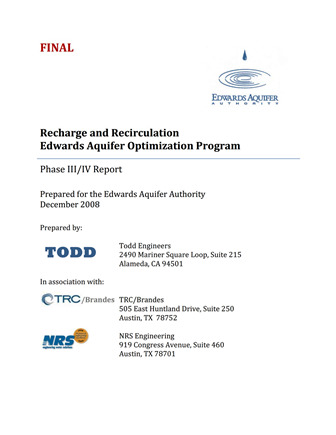Recharge and Recirculation / Edwards Aquifer Optimization Program Phase III / IV Report Final

| Author | Todd Engineers, TRC Brandes and NRS Engineering |
| Year | 2008 |
| Description | Continued and final analyses using improved flow model and recent agency rules for optimizing recharge and streamflow in the Edwards Aquifer |
| Publisher | Todd Engineers |
| Location | Edwards Aquifer, Balcones Fault Zone, Comal Springs, San Marcos Springs, San Antonio Pool |
| Cover | View Download |
| File | View Download |
| Summary |
|
The R&R – Phase III/IV Report consists of baseline modeling scenarios, evaluation of R&R facility operational parameters, evaluation of source water availability, scenario modeling, and engineering and cost estimates for seven scenarios. [Excerpted from the Executive Summary and Summary] The study also evaluates combinations of strategies and provides preliminary costs for facilities to support implementation of an R&R program. Benefits to the region are evaluated in terms of increased water supply and maintaining minimum springflow at key springs including Comal and San Marcos springs…. Based on the analyses provided in this report, the following conclusions can be made. |
Search for Documents
Advance Search
Explore EAA's Scientific Reports
- All Reports
- Hydrology and Hydrogeology
- History
- Groundwater Recharge, Recharge Zone
- Groundwater Movement
- Geomorphology and Caves
- Weather Modification
- Geology
- Water Use and Conservation
- Geochemistry
- Water Resources Planning and Management
- Floods and Drought
- Water Quality
- Climatology
- Surface Water / Groundwater Relationship
- Biology
- Springs, Groundwater Discharge
- Archaeology
- RZ Protection
- Aquifer Levels
- Remote Sensing
- Precipitation
- Overview Studies
- Modeling
